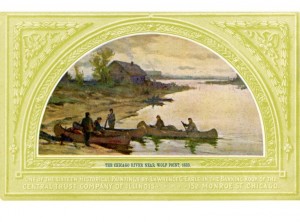Chicago Indians are inevitably pictured in birchbark canoes. Canoes were important for fishing, hunting, wild rice gathering and transportation. However the historical record is less clear as to which type of canoes were used by Native Americans in Chicago.
Birch was rare near Chicago. Thus Chicago Indians might have used local trees to make log or dugout canoes. Although possibly superior on Lake Michigan, log canoes would have been heavy, slow and difficult to carry over the Chicago Portage. The Chicago Portage was a prime reason to come through Chicago in the first place.
Some tribes used elm and other barks to make canoes, although the result was inferior to birch. Most likely the various Chicago tribes obtained birchbark canoes by trade or travel to the north end of Lake Michigan. The Handbook of North American Indians has the following note about the Potowatomi:
"On water, they used both dugout canoes, which were the more common, and larger, built-up framed canoes covered with sheets of birch, white elm, or linden bark. ...Well before 1800, many Potawatomi were substituting horse transportation for canoes, particularly in the Southern reaches of the estate [tribal area], and canoes were increasingly used for local transportation, for fishing and hunting near the village, rather than for long-distance travel."
The Potowatomi was the dominant tribe in the Chicago area in the 1800s, but only one of the many tribes which lived in or traveled through Chicago.
The Atlas of Great Lakes Indian History, while not commenting on canoe building, does say that the canoe route was clockwise around Lake Michigan following the prevailing current. While heading south along the west side of the Lake, there were portages at Green Bay and Chicago to the Mississippi River. A portage route to the Ohio River was available at St. Joseph, Michigan on the eastern side of the Lake. The Chicago Portage was Chicago’s most important feature for hundreds, perhaps thousands of years.
For more information see the Booklist.



Add a comment to: Birchbark Canoes, Continued: Technology That Changed Chicago